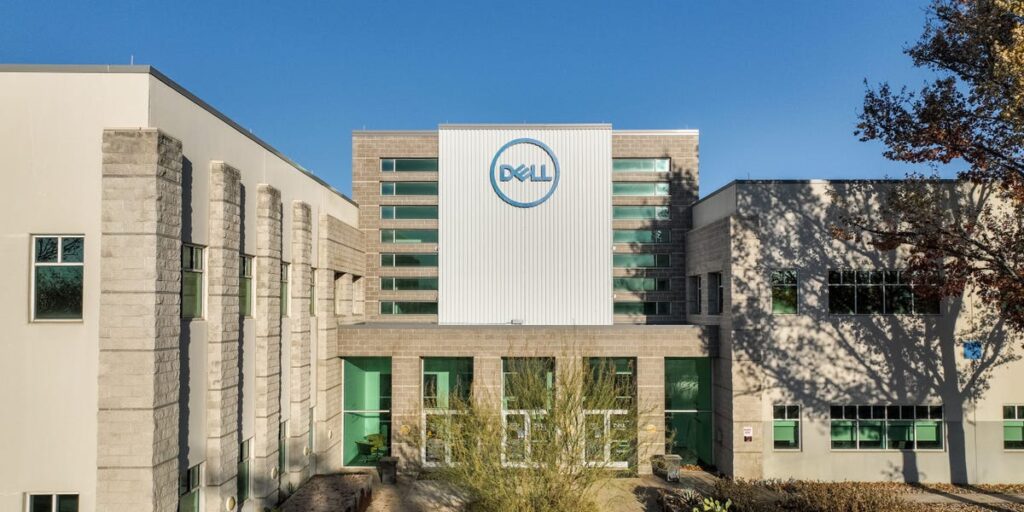There’s a top-secret project underway inside Dell.
Most of Dell’s employees aren’t meant to know about it, and those who do have signed NDAs and been told to keep communications about it to a minimum.
“Do not mention the Project Maverick name,” reads a NDA agreement seen by Business Insider.
But despite its secrecy, “Project Maverick,” as it is codenamed, isn’t a revolutionary piece of hardware or groundbreaking new technology. It’s Dell’s plan to overhaul the company’s operations and streamline all systems, data, and processes into a standardized platform.
Dell sees this transformation as “critical” for its AI strategy and future success, and the company has brought on a team of Deloitte consultants to help guide the project, internal documents about the project obtained by Business Insider show.
“The ‘game’ is changing — we must be far more nimble, decisive, and quick,” one internal document says. “What made us successful in the past won’t take us where we need to go.”
Documents seen by Business Insider include an onboarding presentation and a “guidance and resources” document uploaded to the project SharePoint, describing its scope and intended outcomes. Business Insider has also seen an NDA agreement sent to a Dell employee.
“While we’re not going to discuss the specifics of our internal processes, we prioritize innovation and service to support our team members, customers, and partners,” a Dell spokesperson told Business Insider.
‘Severely outdated’ systems
Project Maverick’s mission is to modernize the 41-year-old company’s vast IT sprawl, part of which Dell inherited during its acquisition of EMC in 2015, the second-largest technology merger ever.
According to the onboarding presentation, Dell’s operations run on roughly 4,700 applications, 70,000 servers, and more than 10,000 databases. That environment is “holding us back,” Dell said in the presentation, because it is so complex and expensive to maintain.
The tangle of systems forces staff into “manual processes and excessive reporting,” diverting energy away from pursuing innovation, Dell said.
One slide breaking down specific functions described Dell’s subscription capabilities as “severely outdated,” its customer resource management as a source of “confusion and inefficiency,” and its stock keeping units, or SKUs, as a driver of “go-to-market delays.”
Two Dell employees told Business Insider that the quality of the tools hampers their daily work. They asked to remain anonymous as they are not permitted to speak publicly, but Business Insider has verified their employment.
“Our tools suck. They’re very old,” said one employee, who has been with the company for more than 10 years.
“It is very hard for us to do our jobs in the Dell ecosystem as it is today,” said a second Dell employee. “Many systems don’t talk to each other, or only do a small piece of a broader process, requiring users to switch between several tools to complete a task.”
The push to consolidate tools is “long overdue,” the person added.
A third employee told Business Insider that while some tools “aren’t very intuitive,” they had few complaints about the ones they use daily.
What will change at Dell?
Dell has been working on Project Maverick since November 2024 and is set to launch for the client solutions group — the part of Dell that sells personal computers, monitors, and other hardware — in February 2026, in line with the start of Dell’s financial year, according to a project timeline seen by Business Insider.
An internal FAQ says there will be a single cutover day, after which most existing systems will be decommissioned. “Friday, it’s going to work one way, Monday, it’s going to work a different way,” explained the Dell employee who has been at the company for more than 10 years and who works on Project Maverick.
The company’s other key business line, the infrastructure solutions group — which provides servers, storage solutions, and other IT infrastructure — is scheduled to be updated in May 2026.
Project Maverick will mean “less time on manual tasks, better data and insights for decision-making, faster response to customer needs, a more agile, competitive Dell,” according to the internal documents.
Changes will include creating a single global catalog, consistent lead times, and automated order management capabilities.
“This is a bold opportunity to deliver the benefits our teams have been asking for and a key enabler of Modern Dell,” the project documents say.
Alongside Project Maverick, major changes have been hitting other parts of Dell’s business. In the last two years, the company’s global head count has dropped by 25,000, marking a 19% decline in personnel.
In July, Jeff Clarke, the longtime vice chairman and COO, announced in an internal memo that he was stepping in to take on CSG’s “day-to-day leadership.”
CSG is the company’s biggest revenue driver, but the division’s revenue has declined for the last three years.
Dell announced another major leadership shift this week — Yvonne McGill, the chief financial officer, has stepped down after nearly 30 years at the company.
Transforming a legacy brand for the AI future
Michael Dell founded his eponymous brand in 1984, under the name PC’s Limited, and it quickly established itself as a trusted maker of office PCs.
Since 1992, Dell has been a Fortune 500 company — barring four years from 2014 when it was taken private — and Dell himself is the world’s 11th-richest man, according to the Bloomberg Billionaires Index.
The company has evolved into a major server and data storage provider, benefiting from the AI boom as demand surges for the infrastructure required to deploy the new technology.
But Project Maverick demonstrates how successful legacy brands must reorient all their operations for an AI-driven future.
Joe Depa, the global chief innovation officer at the Big Four professional services firm EY, told Business Insider that major transformations are “inevitable” as companies implement AI.
“Implementing AI isn’t about dropping a tool into old workflows — it requires rethinking processes, systems, and even business models through an ‘AI-first’ lens,” he said.
Minimizing your operational complexity is crucial because “siloed, manual systems can’t handle the scale, speed, or intelligence AI enables.”
Companies that re-architect their operating models around AI “will set the competitive standard,” Depa added.
Have a tip? Contact this reporter via email at [email protected] or Signal at Polly_Thompson.89. Use a personal email address, a nonwork WiFi network, and a nonwork device; here’s our guide to sharing information securely.
Read the full article here
















